Abstract
Rhodococcus equi is a facultative, intracellular, gram-positive coccobacillus increasingly reported as an opportunistic pathogen in human immunodeficiency virus-positive patients. However, the optimal drug regimen for treating R. equi pulmonary or systemic infections is not yet known. Therefore, a model of intravenously infected nude mice with disseminated infection was created to study the efficacy of antibiotics alone or in combination as determined by the reduction of bacterial CFU per gram in the lungs and spleen after 4 and 11 days of treatment. The studied antibiotics possessing low MICs against R. equi strains were amikacin, ciprofloxacin, erythromycin, imipenem, minocycline, rifampin, and vancomycin. Vancomycin, imipenem, and rifampin were the most effective agents in monotherapy. On the other hand, amikacin, ciprofloxacin, erythromycin, and minocycline alone were not active in this model. The most active drug combinations were those including vancomycin. No antibiotic-resistant mutants were selected in vivo with treatment involving any drugs used alone or in combination. Although the treatment recommended until now for R. equi infections is rifampin plus erythromycin, this study suggests that antibiotic combinations which include vancomycin may be the most effective in vivo.
Full text
PDF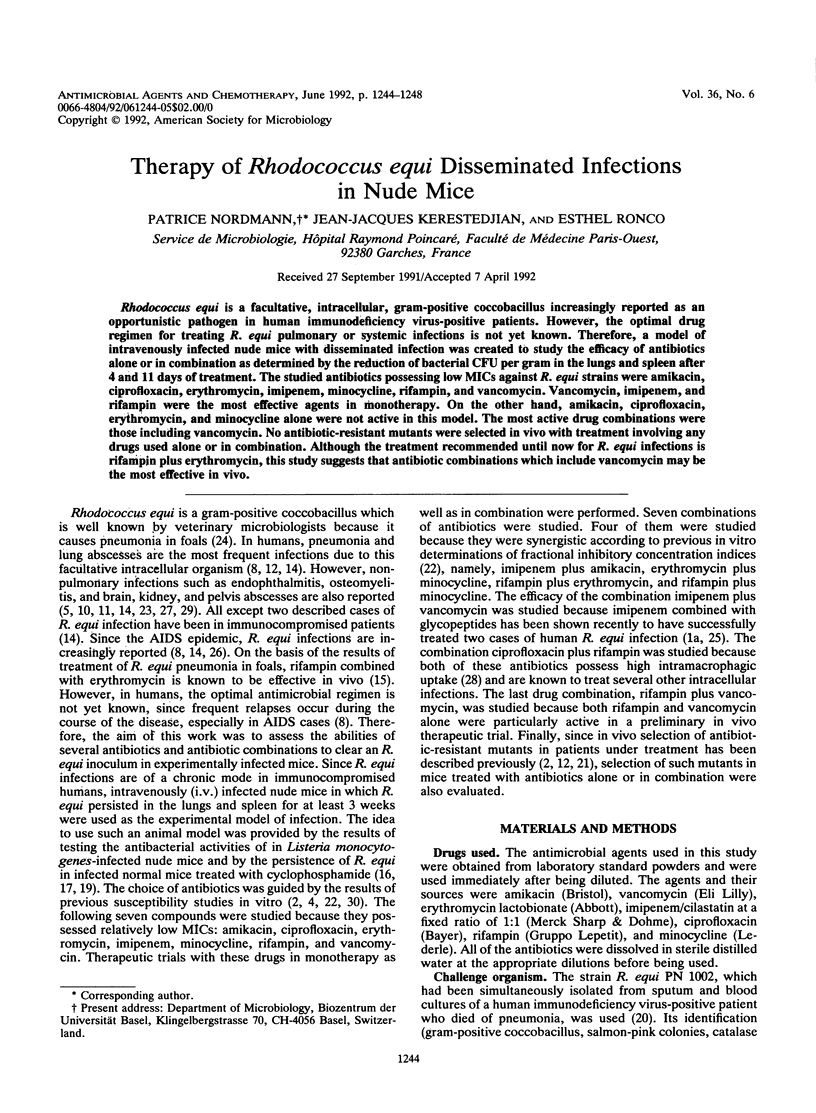
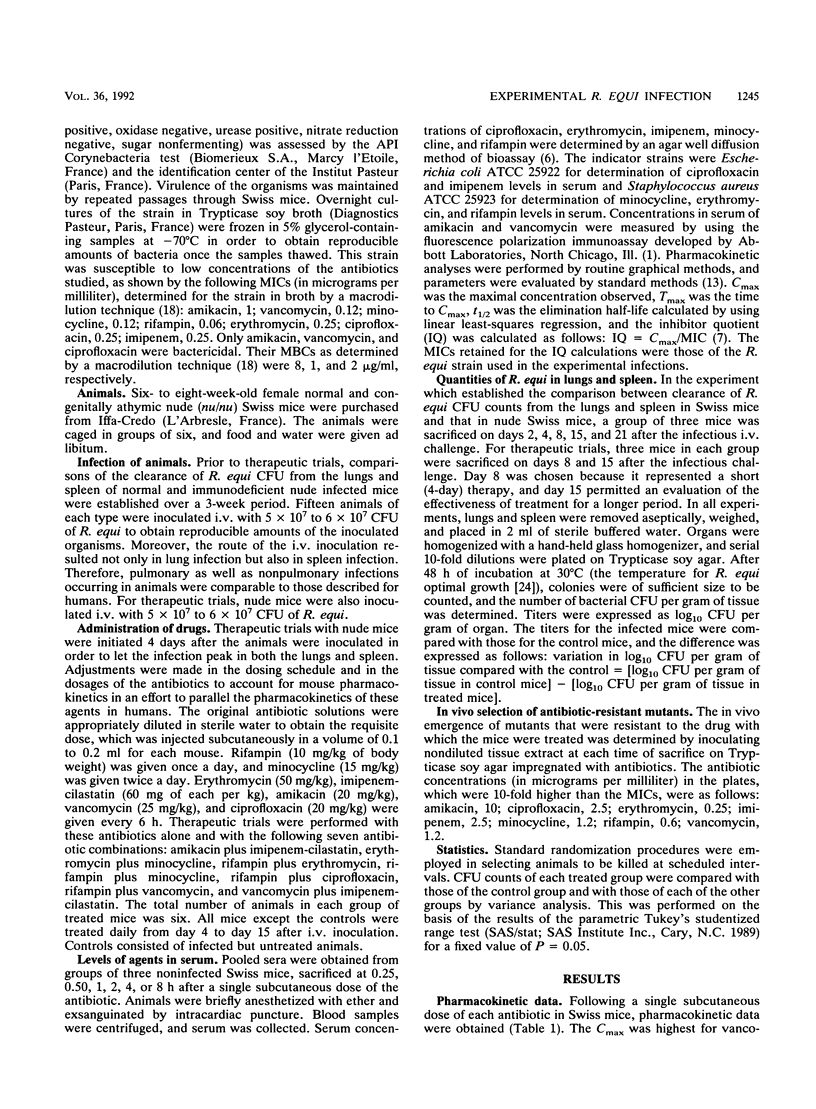
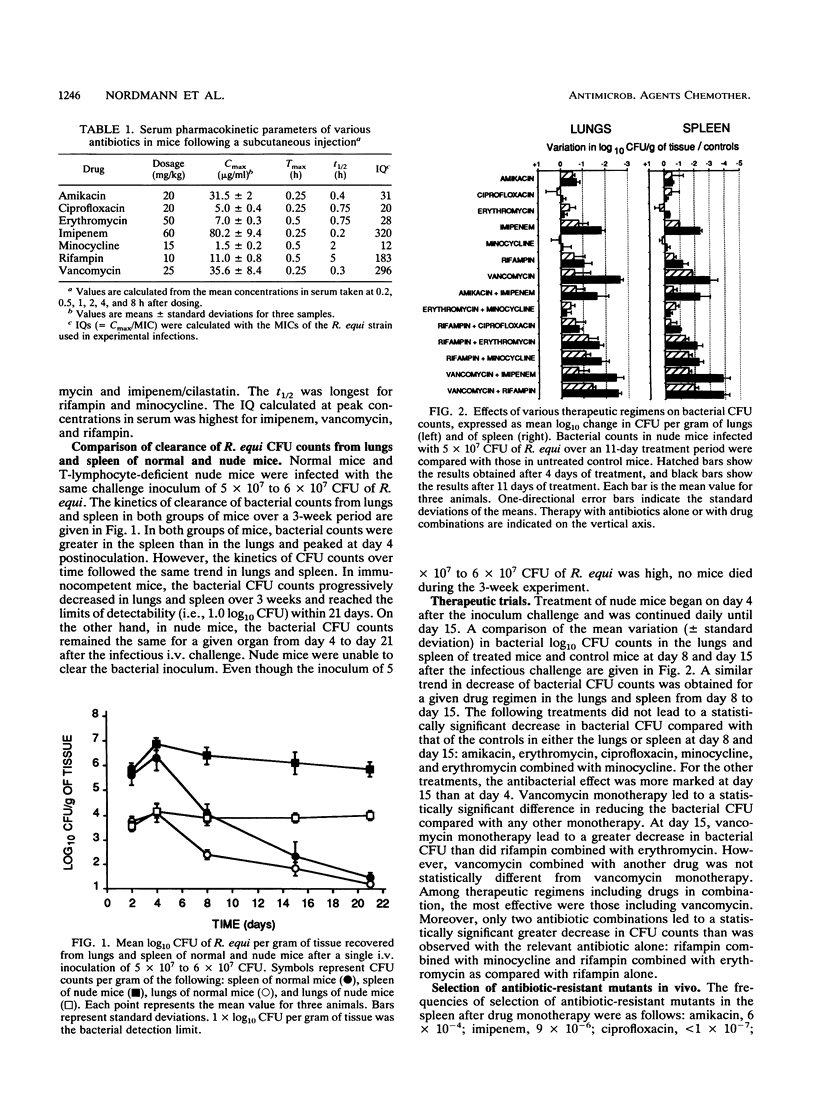
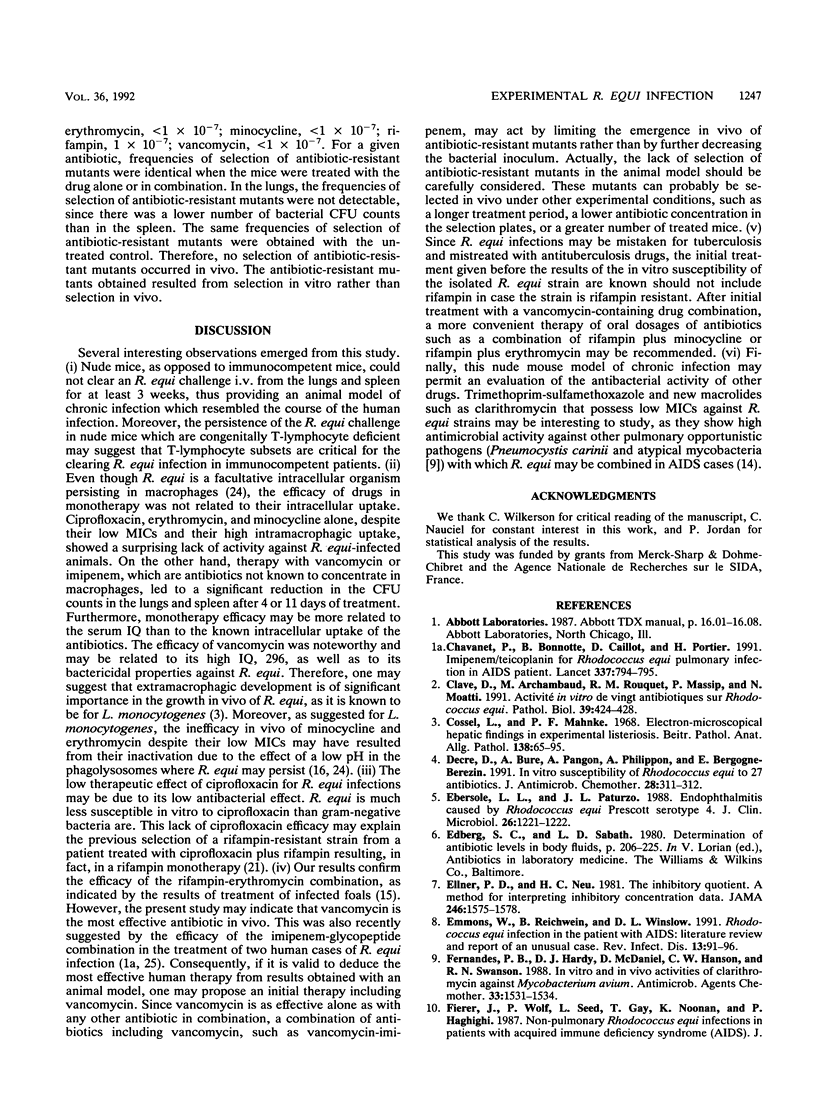
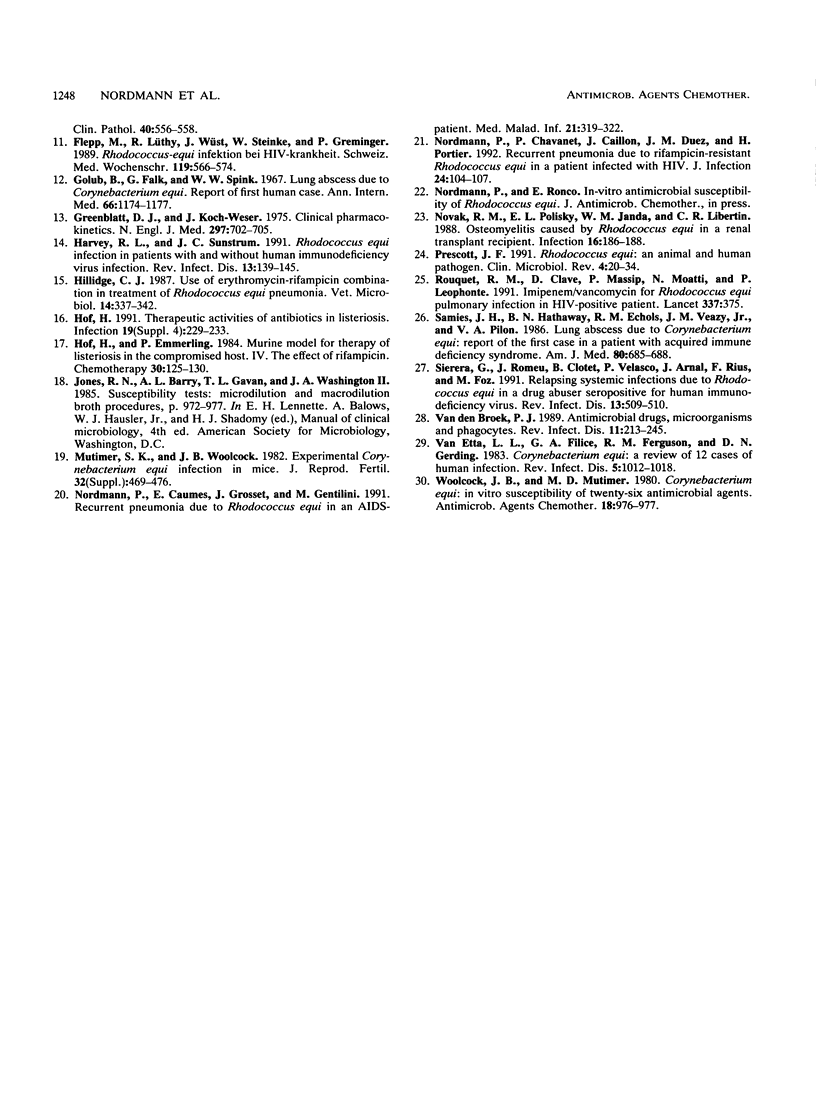
Selected References
These references are in PubMed. This may not be the complete list of references from this article.
- Chavanet P., Bonnotte B., Caillot D., Portier H. Imipenem/teicoplanin for Rhodococcus equi pulmonary infection in AIDS patients. Lancet. 1991 Mar 30;337(8744):794–795. doi: 10.1016/0140-6736(91)91415-q. [DOI] [PubMed] [Google Scholar]
- Clavé D., Archambaud M., Rouquet R. M., Massip P., Moatti N. Activité in vitro de vingt antibiotiques sur Rhodococcus equi. Pathol Biol (Paris) 1991 May;39(5):424–428. [PubMed] [Google Scholar]
- Cossel L., Mahnke P. F. Elektronenmikroskopische Befunde an der Leber bei experimenteller Listeriose. Beitr Pathol Anat. 1968;138(1):65–95. [PubMed] [Google Scholar]
- Decré D., Buré A., Pangon B., Phillippon A., Bergogne-Bérézin E. In-vitro susceptibility of Rhodococcus equi to 27 antibiotics. J Antimicrob Chemother. 1991 Aug;28(2):311–313. doi: 10.1093/jac/28.2.311. [DOI] [PubMed] [Google Scholar]
- Ebersole L. L., Paturzo J. L. Endophthalmitis caused by Rhodococcus equi Prescott serotype 4. J Clin Microbiol. 1988 Jun;26(6):1221–1222. doi: 10.1128/jcm.26.6.1221-1222.1988. [DOI] [PMC free article] [PubMed] [Google Scholar]
- Ellner P. D., Neu H. C. The inhibitory quotient. A method for interpreting minimum inhibitory concentration data. JAMA. 1981 Oct 2;246(14):1575–1578. doi: 10.1001/jama.246.14.1575. [DOI] [PubMed] [Google Scholar]
- Emmons W., Reichwein B., Winslow D. L. Rhodococcus equi infection in the patient with AIDS: literature review and report of an unusual case. Rev Infect Dis. 1991 Jan-Feb;13(1):91–96. doi: 10.1093/clinids/13.1.91. [DOI] [PubMed] [Google Scholar]
- Fernandes P. B., Hardy D. J., McDaniel D., Hanson C. W., Swanson R. N. In vitro and in vivo activities of clarithromycin against Mycobacterium avium. Antimicrob Agents Chemother. 1989 Sep;33(9):1531–1534. doi: 10.1128/aac.33.9.1531. [DOI] [PMC free article] [PubMed] [Google Scholar]
- Flepp M., Lüthy R., Wüst J., Steinke W., Greminger P. Rhodococcus-equi-Infektion bei HIV-Krankheit. Schweiz Med Wochenschr. 1989 May 6;119(18):566–574. [PubMed] [Google Scholar]
- Golub B., Falk G., Spink W. W. Lung abscess due to Corynebacterium equi. Report of first human infection. Ann Intern Med. 1967 Jun;66(6):1174–1177. doi: 10.7326/0003-4819-66-6-1174. [DOI] [PubMed] [Google Scholar]
- Greenblatt D. J., Kock-Weser J. Drug therapy. Clinical Pharmacokinetics (first of two parts). N Engl J Med. 1975 Oct 2;293(14):702–705. doi: 10.1056/NEJM197510022931406. [DOI] [PubMed] [Google Scholar]
- Harvey R. L., Sunstrum J. C. Rhodococcus equi infection in patients with and without human immunodeficiency virus infection. Rev Infect Dis. 1991 Jan-Feb;13(1):139–145. doi: 10.1093/clinids/13.1.139. [DOI] [PubMed] [Google Scholar]
- Hillidge C. J. Use of erythromycin-rifampin combination in treatment of Rhodococcus equi pneumonia. Vet Microbiol. 1987 Aug;14(3):337–342. doi: 10.1016/0378-1135(87)90121-0. [DOI] [PubMed] [Google Scholar]
- Hof H., Emmerling P. Murine model for therapy of listeriosis in the compromised host. III. The effect of rifampicin. Chemotherapy. 1984;30(2):125–130. doi: 10.1159/000238258. [DOI] [PubMed] [Google Scholar]
- Mutimer M. D., Woolcock J. B. Experimental Corynebacterium equi infection in mice. J Reprod Fertil Suppl. 1982;32:469–476. [PubMed] [Google Scholar]
- Nordmann P., Chavanet P., Caillon J., Duez J. M., Portier H. Recurrent pneumonia due to rifampicin-resistant Rhodococcus equi in a patient infected with HIV. J Infect. 1992 Jan;24(1):104–107. doi: 10.1016/0163-4453(92)91234-3. [DOI] [PubMed] [Google Scholar]
- Novak R. M., Polisky E. L., Janda W. M., Libertin C. R. Osteomyelitis caused by Rhodococcus equi in a renal transplant recipient. Infection. 1988 May-Jun;16(3):186–188. doi: 10.1007/BF01644100. [DOI] [PubMed] [Google Scholar]
- Prescott J. F. Rhodococcus equi: an animal and human pathogen. Clin Microbiol Rev. 1991 Jan;4(1):20–34. doi: 10.1128/cmr.4.1.20. [DOI] [PMC free article] [PubMed] [Google Scholar]
- Rouquet R. M., Clave D., Massip P., Moatti N., Leophonte P. Imipenem/vancomycin for Rhodococcus equi pulmonary infection in HIV-positive patient. Lancet. 1991 Feb 9;337(8737):375–375. doi: 10.1016/0140-6736(91)91018-p. [DOI] [PubMed] [Google Scholar]
- Samies J. H., Hathaway B. N., Echols R. M., Veazey J. M., Jr, Pilon V. A. Lung abscess due to Corynebacterium equi. Report of the first case in a patient with acquired immune deficiency syndrome. Am J Med. 1986 Apr;80(4):685–688. doi: 10.1016/0002-9343(86)90825-9. [DOI] [PubMed] [Google Scholar]
- Sirera G., Romeu J., Clotet B., Velasco P., Arnal J., Rius F., Foz M. Relapsing systemic infection due to Rhodococcus equi in a drug abuser seropositive for human immunodeficiency virus. Rev Infect Dis. 1991 May-Jun;13(3):509–510. doi: 10.1093/clinids/13.3.509. [DOI] [PubMed] [Google Scholar]
- Van Etta L. L., Filice G. A., Ferguson R. M., Gerding D. N. Corynebacterium equi: a review of 12 cases of human infection. Rev Infect Dis. 1983 Nov-Dec;5(6):1012–1018. doi: 10.1093/clinids/5.6.1012. [DOI] [PubMed] [Google Scholar]
- Woolcock J. B., Mutimer M. D. Corynebacterium equi: in vitro susceptibility to twenty-six antimicrobial agents. Antimicrob Agents Chemother. 1980 Dec;18(6):976–977. doi: 10.1128/aac.18.6.976. [DOI] [PMC free article] [PubMed] [Google Scholar]
- van den Broek P. J. Antimicrobial drugs, microorganisms, and phagocytes. Rev Infect Dis. 1989 Mar-Apr;11(2):213–245. doi: 10.1093/clinids/11.2.213. [DOI] [PubMed] [Google Scholar]


